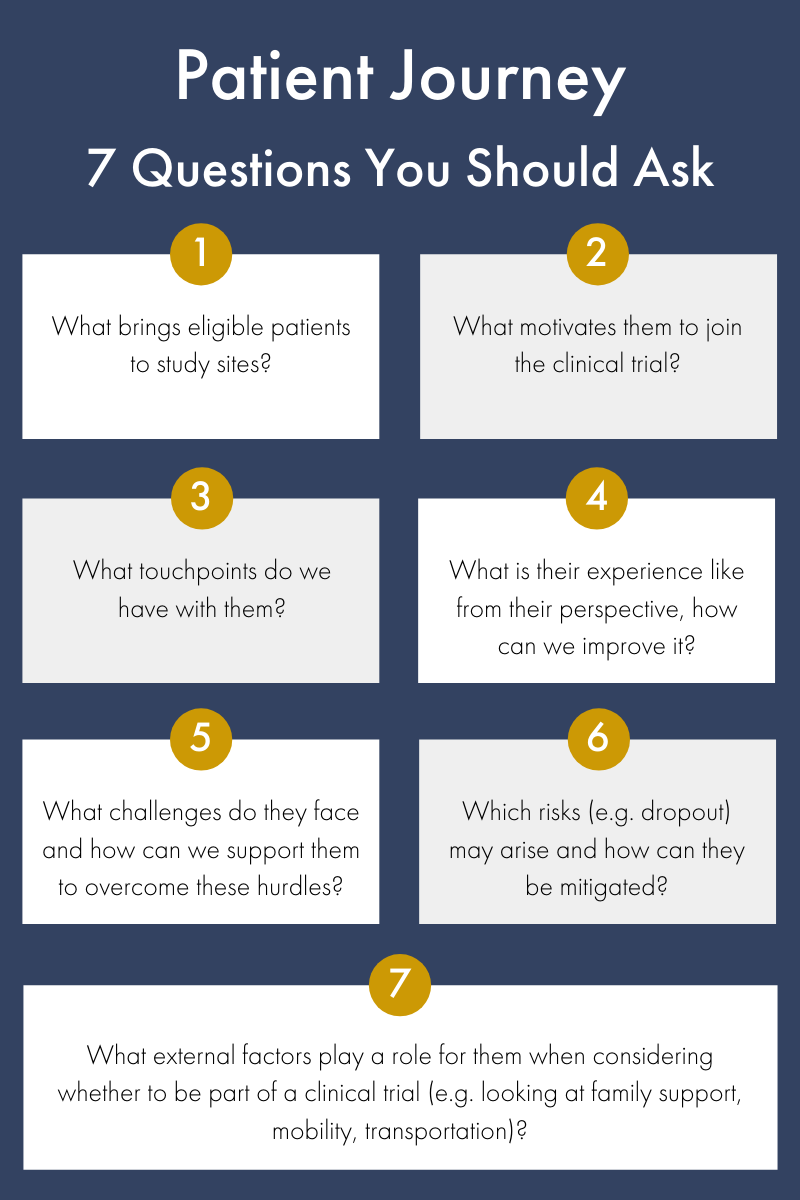Recruiting (the right) patients, onboarding them, and keeping them on board is one of the most critical factors determining the success of a clinical trial. Let’s talk about patient journey mapping.
This is a good news, bad news situation. Let’s start with the bad news: even before the COVID-19 pandemic, this was no easy feat. But there’s also good news: there are ways to make this whole process run more smoothly. It’s called patient journey mapping.
Before we get into the nitty gritty of what that is and how to do it, let’s take a closer look at the recruitment situation as it stands – i.e., the situation you likely find yourself in now, if you are a CRO or sponsor testing new pharmaceuticals or medical devices.
Recruiting Woes
Finding, recruiting, engaging, and retaining study participants might be the hardest part of running a successful clinical trial. To complicate matters even further, you’re usually not looking for just any study participants, but for the right patients to participate in your study.
You’re not alone in this struggle. One study of 114 trials in the UK found that only 31% were able to meet their patient-recruitment goals. Another study found that a staggering 80% of clinical trials fail to recruit the number of participants needed within their timeline targets. A fact that leads to around one-third of publicly funded trials needing a timeline extension. Worse yet, another study found that 19% of clinical trials needed to be halted altogether due to participant recruitment issues.
Add to this the extra complication of recruiting during a global pandemic, where travel restrictions and extra social-distancing measures must be taken into account, and things begin to look grim.
The Consequences Of Not Finding Your Study Participants
Not being able to meet your recruitment goals within your set timelines not only leads to study delays, not to mention delays in your ability to actually treat the patients who need the drugs or devices you are testing, but also a loss in revenue. This can translate to up to $8 million in lost revenue for each day you are delayed.
Why is this happening? COVID-19 aside, there has always been tight competition for eligible participants. This is partly because the recruitment pool is made smaller by an unappealing recruitment process, one too often planned without the user experience in mind. Or at least not tailored to your different groups of participants – patients and control group participants generally join a study for different reasons, and thus need to be approached differently as well.
Yes, this means you might need to rethink the entire participant process, from first contact through to the end of the study. In fact, we urge you to do this. But you don’t have to do it alone – let’s walk through all the details, starting at the beginning.
Patient Journey Mapping
Connecting with potential participants.
How will you reach your participants, the patients vs. control group? What motivates each to want to participate, and what publications or websites might that interest drive them to read or visit?
As Tesheia Johnson, executive director of the Yale Center for Clinical Investigation, put it:
“It’s confirmed that there is a lack of understanding about what’s involved in clinical research and why it’s important to participate.”
How can you overcome this gap?
Next, thinking again about why potential participants would be interested in your study, you need to plan how you will address each group, separately. What message will catch their attention and engage them? What do you have that they need? Do they have a specific concern? Are they looking to make an impact? What phrasing and language will appeal to them most?
We suggest some good target group mapping to uncover each group’s “pain points,” what’s driving them, and how you can make them aware of the potential solution you are offering.
The 7 most important questions you should be asking
When analyzing your patient journey to improve your participant-recruitment process, you should start by asking yourself seven important questions:

Plan, plan, plan
While you are uncovering who your potential participants are and what they want and need, also consider which suppliers you can work with to best meet those unique needs. Build those participant desires and needs into your governance and oversight model for the whole study.
Plan your timelines as realistically as possible, padding them and setting expectations and budgeting appropriate to the high level of risk and possible delays. Think through all of your risks and your back-up plans.
Don’t forget that your participants will need ongoing support throughout the trial to maintain their motivation and commitment. The more attention you can offer, the lower the drop-out rate.
And, different groups of participants will need different types of support. Think about your participants and your study and consider age, the physical demands of your study, how easy it is to access the study location, or send updates remotely. How will the needs of your study fit into your desired participants’ lives, and how can you make them fit better?
Getting Help
Yep, there are a lot of things you need to think about when doing patient journey mapping – and keep thinking about a new throughout your entire clinical trial. You might benefit from some help from someone experienced in this kind of planning and tracking.
Specialized consultancies like Seuss+ can work with you to draw out roadmaps for each of your key stakeholders together. Let’s all sit down and put our heads together to crank this out – it will even be fun! We promise.
After that, we can support you in setting up a more participant-friendly clinical trial, built from the participants’ perspective using innovative new processes and technology.
We’ll also guide you through letting your would-be participants know that, by joining your trial, they’re in for a better experience. Where they’re treated more like clients than patients. And in offering extended support throughout the trial.
The result: dramatically lower drop-out rates, leading to more valuable and successful outcomes.
Get in touch for a free consultation to find out how we can help.






0 Comments